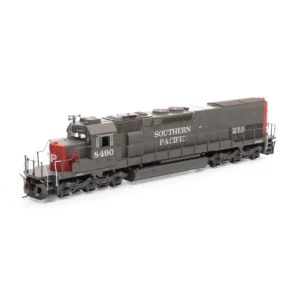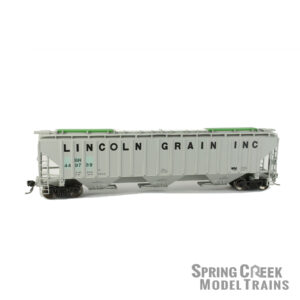Description
Railroad Short Name: GATX
Since the beginning of railroading in the United States, tank cars have been an essential part of the freight car fleet. From their primitive beginnings of barrels mounted to flatcars, tank cars have evolved into complex designs optimized for hauling a variety of liquids, from corn syrup to anhydrous ammonia.
While tank cars are prolific, most railroads do not own large fleets of these relatively specialized cars, preferring to make use of fleets managed by freight car companies, such as GATX. One of the larger equipment management companies, GATX can trace its history to the turn of the century, and is well-known for its large fleet of tank cars of varying designs, many of which were built in-house. One of the more distinctive designs to originate from GATX is the “TankTrain”, which made its debut in the 1970s. The TankTrain concept was a solution to the problem of long load/unload times for unit train shipments of particular commodities, such as crude oil. A typical unit train can take significant time to load or unload, with the need for workers to attach the necessary hoses and other fittings to each individual car, coupled with the necessary time to load or unload the commodity from each car.
The TankTrain was designed to significantly reduce this time. TankTrain cars are interconnected with a large-diameter, flexible hose between each car, which allows the commodity to be siphoned off at a single point at the end of a set of cars while being “pushed” at the opposite end with inert nitrogen gas. Using this method, TankTrain cars can be loaded or unloaded at a rate of approximately 3,000 gallons per minute, allowing a train of 90 cars to be loaded or unloaded in under five hours. This has the obvious benefit of increased equipment utilization, as well as reduced labor costs, and shorter dwell times at terminals. Additionally, TankTrain cars were built in various sizes and designs to handle various commodities resulting in a wide variety of TankTrain cars roaming the nations’ rails.
TankTrain cars are typically grouped into interconnected sets ranging from two to thirteen cars, the set size varying upon the car types, commodity, and shipper being served. One of the commodities routinely handled by TankTrain cars is crude oil, whose viscous nature, and tendency to be shipped in unit train quantities, lends itself well to the TankTrain concept. The most well-known operation using TankTrain equipment was Southern Pacific railroad’s operation of these cars, on behalf of Shell Oil Company, from a loading facility in Bakersfield, California, to a refinery in Carson, California. This operation began in the early 1980s, and proved to be highly succcesful for Shell, allowing them economical transport of Kern County crude oil to their refinery. Two trainsets were operated, allowing a continuous load/empty cycle to operate between the loadout and the refinery. These trains were comprised of insulated cars with a 23k nominal capacity, grouped into sets of 12-13 cars, with a full train being around 75-78 cars (more or less, depending upon cars that may have been cut out of the individual sets for maintenance). This train proved to be a fairly high-priority operation on the Southern Pacific, mainly stemming from the need to make sure the loaded trains arrived at the refinery on time, in order to prevent production disruptions, as well as to make sure the warmed crude oil (heated as a result of the initial extraction process) does not cool and thicken inside of the car, which would slow down the unloading process.
These all-new Athearn Genesis models represent 23K-capacity GATX TankTrain cars from the 486-number series (built in 1977), and 282-series (built in 1982). Based upon GATX diagrams, as well as photos and field measurements taken from prototype TankTrain cars at GATX’s West Colton repair facility, these new Genesis models faithfully replicate the prototype differences between the two different series’, including variations on the tank saddles, walkways, manways, brake rigging, and transfer piping. While these cars are most closely associated with Southern Pacific, TankTrain sets comprised of these cars have been, and can be seen in operation across the country. Grand Trunk Western, for example, operated TankTrain cars from the 486-series in the Great Lakes region, hauling fuel oil, in the late 1970s. And despite construction of a pipeline that eliminated the need for Southern Pacific’s original routing of TankTrain equipment, a new TankTrain, operated by Southern Pacific successor Union Pacific along the former SP “Coast Line”, operates to this day with many of the same cars, from a loading facility in San Ardo, California, to a refinery in Carson, California.
Tank Train Features:
- Two GATX classes represented: 282-series and 486-series
- Correct walkways, manways, and load/unload pluper series
- Finely detailed walkways with “saw-tooth” tread pattern
- Correct transfer plumbing per prototype series and end (A-end or B-end)
- Full underbody plumbing and rigging
- Detailed, soft vinyl transfer hoses that bend as the car negotiates curves
- Cars available as end unit sets and as individual intermediate units
- Genesis 100-ton roller-bearing trucks with spinning bearing cap detail
- Minimum radius: 18”
- Recommended radius: 22”
- 282-series era: 1977 to present
- 486-series era: 1982 to present
Car Features:
- Fully-assembled and ready-to-run out of the box
- Accurately painted and printed for prototypical realism
- Highly-detailed, injection-molded body
- Separate wireform grab irons, etched metal coupler platforms
- Coupler lift bars, trainline hoses, brake hoses, and hardware
- Full underframe detail: air brake reservoir, control valve, and brake cylinder with plumbing and brake rod details
- Trucks with rotating bearing caps
- Machined metal wheels
- Weighted for trouble free operation
- Wheels with RP25 contours operate on Code 70, 83, 100 rail
- Body-mounted, McHenry operating scale knuckle couplers
- Multiple road numbers







Reviews
There are no reviews yet.